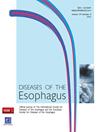539.临床 I 期食管癌根治术等待期与术后复发的关系
IF 2.3
3区 医学
Q3 GASTROENTEROLOGY & HEPATOLOGY
引用次数: 0
摘要
背景 根据潜在的淋巴结转移风险进行食管切除术和局部淋巴切除术是目前治疗临床 I 期胸部食管癌的标准方法。通过内镜黏膜下剥离术(ESD)进行局部切除是临床 0 期食管癌的标准治疗方法,但对于病理 T1b 病例,由于潜在的转移风险,手术被认为是额外的治疗方法。根据肿瘤深度和血管侵犯情况等,病理证实有高转移风险的病例可在ESD后进行额外切除。与临床Ⅰ期的手术病例相比,这些病例很多都有很高的转移风险,因此预后普遍较差。此外,ESD 导致的从初诊到根治术的等待时间延长也可能是预后不良的一个因素,但目前对其风险尚无共识。因此,我们进行了一项研究,以明确术前等待时间(WP)对临床 I 期食管癌手术复发风险的影响。方法 我们回顾性评估了本院 65 例因临床Ⅰ期食管癌接受原发性食管切除术和胃管重建术的患者以及 22 例在 ESD 后接受额外切除术的患者的术前等待期与术后 3 年无复发生存率(3y-RFS)之间的关系。结果 87例患者的WP为2.12±1.43个月(平均±标清),13例患者术后复发(3y-RFS 85.1%)。以 2.83 个月(平均值+0.5 SD)为临界值,对短或长 WP 进行双臂比较,结果显示与 3y-RFS 无明显关联(100% vs 81.4%,P=0.071)。WP与ESD之间存在很强的相关性(r=0.647,p<0.01)。65名接受手术作为初始治疗的患者的WP为(1.69±1.20)个月(平均值±标清值),12名患者术后复发(3y-RFS 81.5%)。以 2.29 个月(平均值+0.5 SD)为临界值的短 WP 或长 WP 的双臂比较表明,这与 3y-RFS 有关(85.7% vs 55.6%,P=0.018)。结论 虽然这是一项单中心、小病例的回顾性研究,而且由于事件数量较少,仅是一项单变量研究,但它表明手术前等待时间较长可能是术后复发的一个风险因素。本文章由计算机程序翻译,如有差异,请以英文原文为准。
539. ASSOCIATION BETWEEN WAITING PERIOD FOR RADICAL SURGERY AND POSTOPERATIVE RELAPSE IN CLINICAL STAGE I ESOPHAGEAL CANCER
Background Esophagectomy with locolegional lymphanedectomy based on potential lymph node metastatic risk is the current standard treatment for clinical Stage I thoracic esophageal cancer. Local excision by endoscopic submucosal dissection (ESD) is the standard treatment for clinical Stage 0, however surgery is considered as an additional treatment for pathological T1b cases due to potential metastatic risk. Cases of additional resection after ESD are those pathologically demonstrated to have a high risk of metastasis based on tumor depth and vascular invasion, etc. Compared to cases of surgery for clinical Stage I, many of these cases have a high risk of metastasis, and therefore a poor prognosis is generally expected. Addionally, the prolonged waiting time between initial diagnosis and radical surgery due to ESD may be a factor in poor prognosis, but there is currently no consensus on the risk. Therefore, we conducted a study to clarify the effect of waiting period before surgery (WP) on the risk of recurrence in clinical Stage I esophageal cancer surgery. Methods We retrospectively evaluated the association between WP and 3-year postoperative recurrence-free survival (3y-RFS) in 65 patients who underwent primary esophagectomy and gastric tube reconstruction for clinical Stage I esophageal cancer and 22 patients who underwent additional resection after ESD at our hospital. Results The WP of 87 patients was 2.12 ± 1.43 months (mean± SD), and 13 patients had postoperative recurrence (3y-RFS 85.1%). A 2-arm comparison of short or long WP with a cutoff value of 2.83 months (mean+0.5 SD) showed no clear association with 3y-RFS (100% vs 81.4%, p=0.071). A strong correlation was shown between WP and ESD (r=0.647, p<0.01). WP was 1.69±1.20 months (mean± SD) in 65 patients who underwent surgery as initial treatment, and 12 patients had postoperative recurrence (3y-RFS 81.5%). A 2-arm comparison of short or long WP with a cutoff value of 2.29 months (mean+0.5 SD) suggested an association with 3y-RFS (85.7% vs 55.6%, p=0.018). Conclusion Although this is a single-center, retrospective study of a small number of cases and only a univariate study due to the small number of events, it suggests that a longer waiting period before surgery may be a risk factor for postoperative recurrence.
求助全文
通过发布文献求助,成功后即可免费获取论文全文。
去求助
来源期刊

Diseases of the Esophagus
医学-胃肠肝病学
CiteScore
5.30
自引率
7.70%
发文量
568
审稿时长
6 months
期刊介绍:
Diseases of the Esophagus covers all aspects of the esophagus - etiology, investigation and diagnosis, and both medical and surgical treatment.
 求助内容:
求助内容: 应助结果提醒方式:
应助结果提醒方式:


